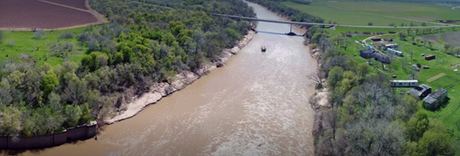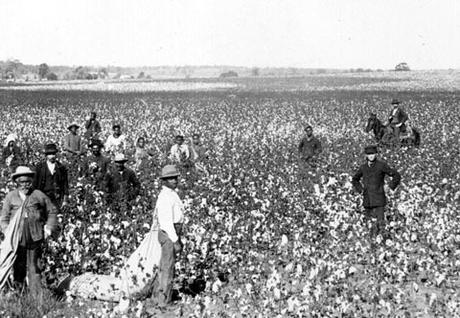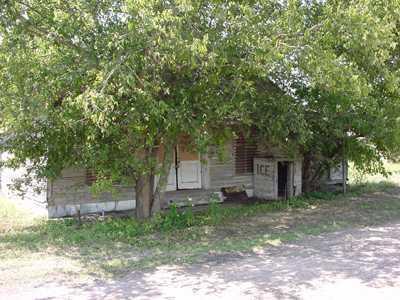Shaun Cooks is a Texas inmate convicted of firing two shots at a sheriff’s deputy. Cooks says he didn’t have a gun with him that night. You can find the entire series here.
On the fateful night of December 20, 2009, Shaun Cooks brought the Mercedes he was driving to a screeching halt shortly after passing County Road 260. Slamming the drivers door behind him, Shaun raced across a farmers field. Stopped by a barbed wire fence, he could see Chris White’s patrol car following him across the field. Why did Shaun stop and run? Why not just keep driving and hope for the best?
There were two good reasons. Shaun spent a lot of time listening to police scanners. He knew how cops operate. The deputy chasing him at speeds in excess of 100 mph, would have been on the radio with every police officer in a twenty-mile radius. Milam and Robertson counties are separated by the Brazos River. The county line is the middle of the Port Sullivan Bridge, and that’s where his friends in blue would be waiting for him.
 The Port Sullivan Bridge
The Port Sullivan BridgeBut there was a second reason. CR 260 is nothing but a narrow, rutted, dirt road. But for Shaun, it was holy ground. Some of his closest family members were buried in a nondescript cemetery just up that road. Shaun was a ten-minute hike from the old Port Sullivan church where his aunt used to live. He had visited this road hundreds of times as a child. He had even lived on this road himself. He had hauled thousands of bails of hay off these fields as a farm hand.
Hardly anyone lived out here anymore, of course. For three generations now, it had been getting harder and harder for anybody, especially Black people like Shaun, to wring a living from this land. Gradually, over a period of decades, everybody gave up and moved to town. Some moved to Cameron, others to Hearne, or Dallas, or to the oil fields in West Texas.
Our story plays out on both sides of the Brazos River, in Milam and Robertson counties. In the days before the Civil War, the land near the banks of the Brazos was home to vast cotton plantations. In the early 1840s, with the Civil War waiting in the wings, the slaveowners of Arkansas and Louisiana were getting restless. Eager to move their slaves to a less vulnerable location further west, they started settling along the banks of the Brazos. In less than a decade, a wildly successful slave economy was established.
The region exploded in the decade before the war. So much so, in fact, that millions were invested buying slave labor. When Texas joined the rebellion, support for the Confederacy became mandatory. In 1860, two White brothers were lynched in Port Sullivan. They were suspected of being abolitionists. There last names were Boatwright; their Christian names are lost to history. This happened just a mile or two from the spot where Shaun Cooks and Chris White had their fateful confrontation.
Even with hundreds of fighting men in uniform, the war years were particularly lucrative for white plantation owners. But the Emancipation Proclamation marked the death knell of the plantation economy. Most of the wealth of the region was driven by free slave labor and without it, the loss of which created a general economic collapse. Gradually, former slaves evolved into sharecroppers (also known as tenant farmers). Most white tenant farmers owned their own mules and equipment and only had to turn over a third of the crop to the land owner. Black tenant farmers had nothing but their own labor to contribute to the enterprise—they had to turn over half of their crops.
Until the 1890s, freed Black tenant farmers enjoyed a measure of freedom. In the region around the Brazos, there were as many Black residents as White, and whoever controlled the Black vote enjoyed the balance of power. The 1890s marked the high point of populist politics, with liberal Democrats and the People’s Party driving the action. Wealthy landowners offered as much as $6 dollars ($170 in today’s money) to buy a vote. For tenant farmers living a hand-to-mouth existence, with families of eight-to-ten people crammed into dilapidated, unventilated, one-room shacks, this was an offer they couldn’t refuse.
 Picking cotton near Port Sullivan, Texas
Picking cotton near Port Sullivan, TexasSo it was that the progressive movement in Texas conspired to put an end to Black voting. The lynching of Alex Johnson in Milam County, described earlier in this story, was part of the movement to put Black people back in their place. In 1896, Black voters in Robinson County were met with White men armed with “rifles, pistols and sticks”. The threat of violence, combined with the poll tax and white-only primary elections, put an end to Black political power. In spite of threats and intimidation, 5500 citizens cast votes in Robertson County that year. In 1904, only 1500 voters were allowed to vote.
In the lean years following the Civil War, the passage of “Black Laws” made it essentially illegal to be Black and unemployed. Men who couldn’t find work were charged with vagrancy, or loitering, and shipped off to prison. Since a cash-strapped Legislature had no money to run the massive prison system demanded by these policies, prisoners were frequently leased out to businesses and farming operations. This “convict lease” system amounted to slavery by another name. The wealthy landowners around the Brazos made the most of the opportunity. Growing cotton was extremely labor-intensive and prison inmates came cheap.
The last decade of the nineteenth century saw a massive influx of white farmers to the region around the Brazos. Desperate for field labor, landowners sent delegations to the states of the former Confederacy promising improved living conditions for Black families willing to relocate. The populations of both Milam and Robertson counties would eventually rise to over 30,000 in the early twentieth century; much higher than it is today. In those days, Blacks briefly outnumbered Whites in Robertson County.
By 1930, most Texans lived on farms, and three quarters of Texas farmers were sharecroppers. In that year, only 6% of the population of Milam County had graduated from high school. Illiteracy was widespread. Then the great depression hit the state, accompanied by years of terrible drought. Commodity prices plunged.
Few farms had access to electricity at the time. Refrigeration was limited. Clothes had to be washed by hand. Meals were cooked over wood stoves. That began to change as the Roosevelt administration stressed rural electrification. The New Deal also provided work for unemployed Texans, most of them ex-farmers; but this assistance was rarely extended to Black Texans. As Ira Katznelson has demonstrated, progressive politics was popular throughout the South so long as it excluded Black citizens.
Beginning in the 1940s, the mule made way for the tractor and Texas agriculture was revolutionized. It wasn’t long before only big farms could turn a profit. Tenant farming became a relic of the past as the demand for farm labor plummeted. In the area in which Shaun Cooks’ family had once farmed, sharecropper shacks were abandoned and rural communities like Branchville (just up the road from where Shaun had his encounter with Chris White) became ghost towns. cotton farms were giving way to cattle operations.
 An abandoned building in Branchville, Texas
An abandoned building in Branchville, TexasFinding it impossible to eke out a living, rural residents moved to cities like Dallas and small towns. Hearne, the largest community in Robertson County, was just on the other side of the Brazos from where Shaun’s extended family lived. With 31% of its population living under the poverty line, Hearne was not a prosperous community. In 1990, when Shaun was in elementary school, the Hearne Wal-Mart closed down and was converted into the new high school. Poor Black families settled in dilapidated homes or moved into a large public housing complex known as Columbus Village.
Shaun’s family moved back to the country for a year when he was a small boy. He remembers watching his cousins swim in the cattle tank. It was a hand-to-mouth existence. They’d shoot squirrels and roast them for dinner. Hunger was never far away. Eventually, the family yielded to the inevitable and settled in Hearne.
Living on the Black side of Hearne meant dealing with the police. Whenever a crime was committed, this was the first place the police would look for suspects. It wasn’t unusual for the police to stop Shaun and his friends as they drove their bikes. “They’d put our bikes in the trunks of their cars,” he says, “and put us in the back seat. They wouldn’t tell us where we were going. They’d take us to a crime scene where a purse had been stolen or a car had been broken into.” Shaun and his friends would be paraded in front of the crime victim and, when it was established that they couldn’t be connected to the crime, the officers would relax, crack a few jokes, and drive the boys home.
“We couldn’t tell our parents,” Shaun says, “because we would get into trouble.” As the boys grew older, they would run off when the police confiscated their bikes, yelling taunts and insults over their shoulders. By this time, Shaun’s uncles were regarded with suspicion and Shaun was being associated with his uncles.
Handsome and athletic, Shaun was popular at school. But while the cool kids were wearing Air Jordans and Guess jeans, he was wearing bargain basement attire from Wal-Mart. His mother, Lois, was working as a certified nurse’s assistant. The pay was low, but by working holidays and lots of overtime, she was just able to keep her children fed and clothed. “But I wasn’t buying anything fancy,” she tells me, “we didn’t have money for that.”
Looking back, Shaun can sympathize with his mother’s plight; but as a school kid he just wanted to dress like the cool kids. The girls he wanted to impress said they would only go out with him if he “dressed better”.
With his mother working overtime, Shaun started running the streets. Smarter than most of his friends, he found he could skip classes and still get passing grades. He tried to make some spending money by hauling hay for farmers, but the work was seasonal and paid next to nothing.
In The Fire Next Time, James Baldwin remembers the summer he turned thirteen. Baldwin was writing about Harlem in the 1930s, not Hearne in the 1990s, but he described the same reality. “It was a summer of dreadful speculations and discoveries,” Baldwin says, “crime became real, for the first time—not as a possibility but as the possibility. One would never defeat one’s circumstances by working and saving one’s pennies; one would never, by working, acquire that many pennies.”
When Shaun Cooks was thirteen, he was hanging out with his uncles and some of their older friends.
They were counting money, and I was looking. Impressed, I asked, ‘How did y’all get all that green?’ They showed me, crack cocaine and marijuana. I was amazed that people pay for that junk. One guy placed one rock in my hand and said “$20”. I couldn’t believe it. My uncle took it out of my hand and told my friend and me never to smoke this junk.”
By the age of fourteen, Shaun’s mother laid down the law. If he didn’t quit running the streets, he had to move out. He was becoming a bad influence on his younger siblings. Shaun moved in with his grandfather, a man who had always been dear to him. It wasn’t long before Lois and the rest of the family moved across the street.
By this time, Shaun’s grandfather had been diagnosed with Alzheimer’s disease and needed tending. Shaun would make sure his grandfather was up and dressed in the morning and made sure he got regular meals. He stopped going to school. “I was like, man, I’m tired of being broke,” he says. “The older teenagers were buying alcohol, marijuana and crack to sell. So, one day, I gave a $10 bill to a guy for a $20 crack rock.”
Afraid to sell it in Hearne for fear his mother would find out, Shaun kept the rock in his pocket until he was able to get a ride to a nearby town. In five seconds, he had made more money than he would get for a whole day in the hay fields.
Like Shaun Cooks, little Texas towns like Hearne were strapped for cash and feeling the pinch. The only growth industry was the criminal justice system. In the governor’s race of 1994, George W. Bush and Ann Richards were trying to convince Texas voters that they would be the toughest on crime.
- By 1999, 29% of the young Black males in Texas would be controlled by the criminal justice system (prison, jail, probation or parole).
- In the years since Shaun was born, the Texas prison population had grown by 329%, and the number of men in county jails had increased by 509%.
- While incarceration rates in urban areas had doubled during this period (198%); rates in rural areas like Milam and Robertson counties had quadrupled (394%).
- Between 1995 and 1999, the prison population of Texas would grow by 61%.
It takes big money to grow a criminal justice system this rapidly. Across the state, narcotics task forces were being organized to rid Texas of young men like JeJuan Shauntel Cooks. Corruption was inevitable and, as we will soon see, Robertson County was at the heart of the action.
